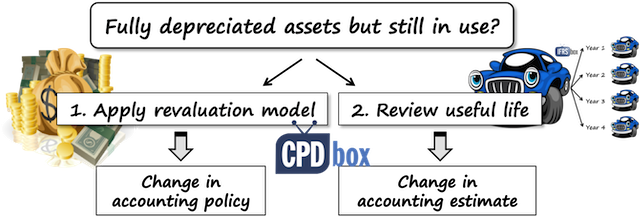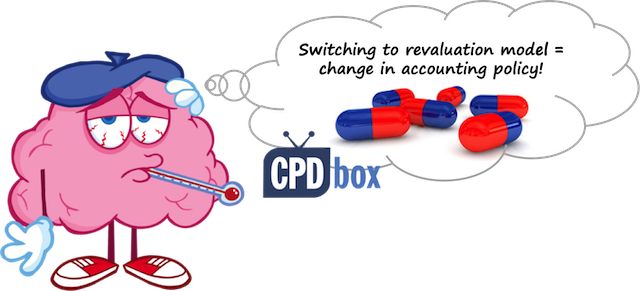Should You Write Off an Asset Completely if It is Still Being Sold and Production is Continuing
Do you work in the production company? And did you find out that some of your production assets are still in operation but they were fully depreciated ?
In this case, the original estimate of machinery's useful life proved to be incorrect.
Here's one of the questions I received:
"Dear Silvia, we are a manufacturing company. We use our existing machinery for a longer period than its useful life and therefore, our machinery is fully depreciated. What can we do to correct it?"
What's wrong with that?
The problem is that as these machines are used beyond their useful life , they are fully depreciated and their carrying amount is zero.
Special For You! Have you already checked out the IFRS Kit? It's a full IFRS learning package with more than 40 hours of private video tutorials, more than 140 IFRS case studies solved in Excel, more than 180 pages of handouts and many bonuses included. If you take action today and subscribe to the IFRS Kit, you'll get it at discount! Click here to check it out!
But in this case, what depreciation expense can you recognize in the profit or loss?
None, of course – because the carrying amount of your property, plant and equipment cannot decrease below zero .
So in fact, you use the machines, but you can't really recognize any depreciation expense, because there's nothing left. You have fully depreciated these assets in the previous reporting periods.
And as a result, the matching principle does not work here. The expenses simply do not match the benefits gained from these machines.
The problem is in the machines' useful lives
The standard IAS 16 Property, plant and equipment defines the useful life as either:
- The period over which an asset is expected to be available for use by an entity, or
- The number of production or similar units expected to be obtained from the asset by an entity.

It is not the potential or economic life of the asset. These two will often not be the same!
For example, normal economic life of a car is 4 years, but the company's policy is to renew car park every 2 years. In this case, car's useful life is just 2 years.
Or, the economic life of a machine is 6 years, but after 3 years, the company's experts assess that the machine can be used for another 5 years. In this case, total useful life is 8 years.
Now this is extremely important: Standard IAS 16 requires entities to review assets' useful lives at least at each financial year-end.
You would not believe how many entities simply forget it!
They just book the annual depreciation charge based on the rates determined for some group of assets and that's it.
They do not revise the useful lives of their assets and as a result, they end up with using fully depreciated assets in the production process.
How to fix this situation?
Let me suggest 2 possible corrective actions for this situation.

Solution 1: Review useful lives at each financial year-end.
Useful life is an accounting estimate and if you find out that it is different from what you initially set, you need to book this change in line with the standard IAS 8 Accounting Policies, Changes in Accounting Estimates and Errors.
It means that you simply set the new remaining useful life, take the carrying amount and recognize the depreciation charge based on the carrying amount and new remaining useful life.

No restatement of previous periods' financial statements is permitted. IAS 8 requires recognizing change in accounting estimates prospectively (now and in the future).
Now you might say: OK Silvia, I got it, but what should I do when the carrying amount (net book value) of my assets is zero?
Well, it depends.
If you reviewed the useful lives in the past regularly and during the current reporting period you find out that you'd like to use the assets even longer, then there's not much to do. Just leave these assets as they are and make sure you avoid this situation in the future.
However, if you really forgot to revise the useful lives in the previous reporting period, this failure to apply IAS 16 results in the accounting error .
If this error is material, then you should correct it retrospectively in line with IAS 8 . It means restating the previous periods using the revised estimated useful lives. Huge amount of work!
Solution 2: Revalue your assets to their fair value.
Standard IAS 16 permits 2 models for subsequent measurement of your property, plant and equipment: cost model and revaluation model.
And it is true that if you still plan to use existing machines in the future, their fair value is for sure greater than zero.
Revaluing machines with nil book value would effectively mean that you are changing your accounting policy and here the standard IAS 8 gets the word again.
In line with IAS 8, you shall change the accounting policy only if:
- The change is required by an IFRS. This is definitely not the case.
- The change results in the financial statements providing reliable and more relevant information about the effects of transactions, other events or conditions on the entity's financial position, financial performance or cash flows.
You (and your auditors) can argue that point 2 exactly reflects your situation. But does it really?
It definitely solves nil book value at the end of the current reporting period. Like a pill provides immediate relief from headaches.
But the accounting policy represents some rules and standards setting how you will report certain transactions in the financial statements – not only now, but also in the future.
It's not like a pill providing immediate relief. It is like a remedy treating the route cause and making you healthy for a long time, so that you don't need to take pills anymore. But what if you apply the wrong pill?

So, do you think that changing your accounting policy from cost model to revaluation model would make you provide better information about your machinery, not only now but also in the future?
Special For You! Have you already checked out the IFRS Kit? It's a full IFRS learning package with more than 40 hours of private video tutorials, more than 140 IFRS case studies solved in Excel, more than 180 pages of handouts and many bonuses included. If you take action today and subscribe to the IFRS Kit, you'll get it at discount! Click here to check it out!
Before you answer that question to yourself, please consider this:
- You need to apply the standard IFRS 13 Fair Value Measurement in order to determine the fair value of your machines. It's very difficult and impracticable.
How can you set the market value of used production machines (mainly if they are so specific to your company)? - Revaluation model is used for buildings and land in 99.9% of cases, because it's easy to set the market value of these assets regularly.
Is it the case for used production machines, with some specialized nature that only a few similar companies can use them? - You need to revalue your machinery with the sufficient regularity . Can you set the fair value let's say annually?
- You need to revalue the entire class of assets , not on an individual basis. Can you really set the fair value of all machinery? How practical is it?
If after considering all these aspects you still want to switch from cost model to revaluation model, then IAS 8 makes it easy for you. You don't need to apply the new policy retrospectively, just prospectively – so no restatement of previous periods .
What solution should we select?
It depends, really.
In my opinion, it's much better to review estimated useful lives at each financial year-end and recognize the change in accounting estimate, rather than opt to change the accounting policy just for the purpose of curing immediate headaches.
From the long-term point of view, revaluation model is not really suitable for machines used in the production process, especially when they have a specialized nature and their main recovery lies in the production of other assets and not in the capital gains resulting from the movements of their market prices.
Yes, I understand that the potential correction of error resulting from failure to review useful lives in the past can be quite painful process, because you need to make lots of calculations. But you do it JUST ONCE.
Please watch the following video with the STEP BY STEP illustration of treating this problem:
Did this explanation help you? Or, do you have a different opinion?
I would really love to hear that! Please leave a comment right below this post. Thank you!
Source: https://www.cpdbox.com/machines-fully-depreciated-still-in-use/
0 Response to "Should You Write Off an Asset Completely if It is Still Being Sold and Production is Continuing"
Postar um comentário